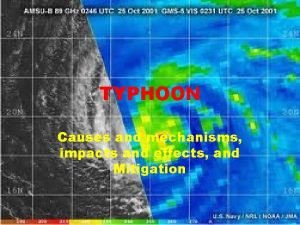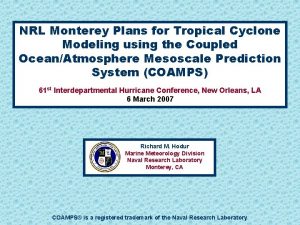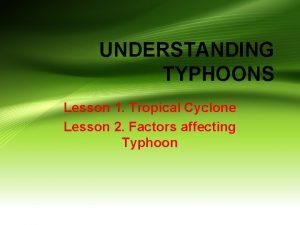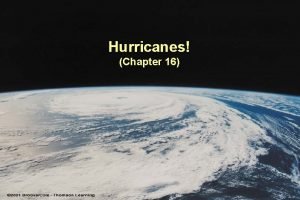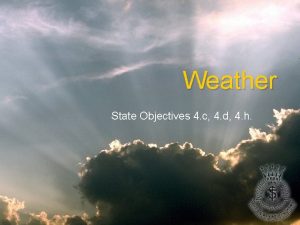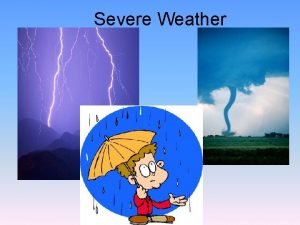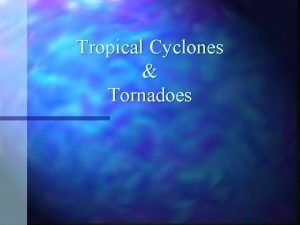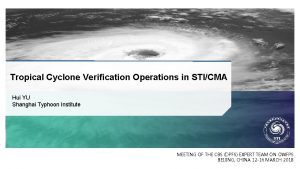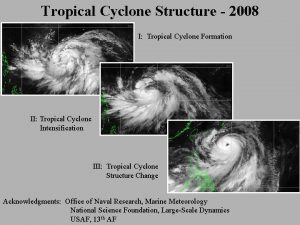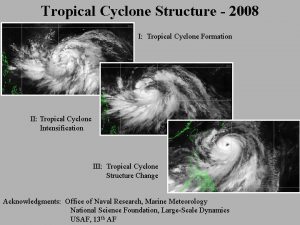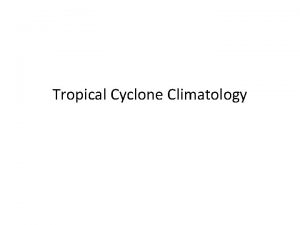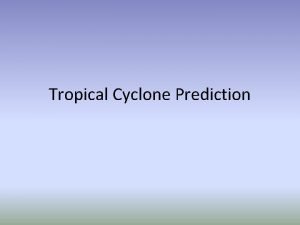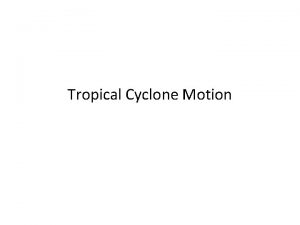Tropical Cyclone Structure 2008 I Tropical Cyclone Formation








- Slides: 8

Tropical Cyclone Structure - 2008 I: Tropical Cyclone Formation II: Tropical Cyclone Intensification III: Tropical Cyclone Structure Change Acknowledgments: Office of Naval Research, Marine Meteorology National Science Foundation, Large-Scale Dynamics USAF, 13 th AF

Tropical cyclone formation, structure and structure change: Challenges to Maritime Operations • Variety of conditions from which a tropical cyclone may form over the western North Pacific Pre-TY Tokage monsoon depression TY Tokage 0000 UTC 14 October 2004 Warning graphics from the Joint Typhoon Warning Center for TY Tokage. The shaded region defines the danger area to be avoided. This area is based on the uncertainty associated with track and outer wind structure over the ensuing five days. TY Tokage: 0000 UTC 14 October 2004 Note: The danger area nearly covers the entire East China Sea for a period of at least 5 days. The change in track forecast from TY Tokage: 1200 UTC 15 October 2004 straight to recurvature, which may be due to the influence of the outer wind structure

Key science questions to be addressed in a program aimed at increased understanding and predictability of tropical cyclone characteristics during formation, intensification, and recurvature over the western North Pacific • Highlights – Incorporates multiple space and time scales • Large scale controls – Global and basin-wide spatial scales – Medium-range and synoptic temporal scales • Mesoscale organization pathways – During formation – During intensification – Primary hypotheses with respect to: • Large-scale role in pre-conditioning • Mesoscale organizational pathways leading to construction of a potential vorticity monolith – Role of low-level convergence associated with deep convective cells – Stratiform regions of mesoscale convective systems • Relative roles of environmental and vortex structures in determining the evolution of the outer wind structure – In tandem with the THORPEX Pacific Asian Regional Campaign (TPARC)

What are the relative roles of the primary mesoscale mechanisms (bottom -up and top-down) in determining the location, timing, and rate of tropical cyclone formation in the monsoon trough environment of the tropical western North Pacific? http: //www. nrlmry. navy. mil/sat_products. html 10 o Pre-Fitow (10 W 2007) disturbance http: //www. nrlmry. navy. mil/sat_products. html 19 o Pre-Man-Yi (04 W 2007) disturbance Objective: Increased predictability associated with the location, timing, and rate of tropical cyclone formation over the western North Pacific

clo Co nes La mb Tr rge ina op a ti ic nd on al Cy Sm type cl all on es Sy n Lar optic ge Tro Type pic : al C y Synoptic Forcing What are the relative roles of environmentally-induced and vortexgenerated mechanisms versus cyclogenesis-determined initial conditions in determining the outer wind structural evolution of western North Pacific tropical cyclones? s e on e: ycl p ty l C e al pica c os Tro s Me all Sm Mesoscale Forcing Objective: Increased understanding and predictability of factors that impact the evolution of the outer-wind structure of an intensifying tropical cyclone over the western North Pacific.

Satellite – Aircraft Comparisons NOAA 43 1430 -1520 Z 10, 000’ TMI 85 H 9 -22 -05 1443 Z NW North Hurricane Rita Graphic supplied by J. Hawkins

Pre- TY 10 W (Fitow) Disturbance Combined missions during tropical cyclone formation Use of Eldora to measure characteristics associated with deep convection Use of WC-130 to measure the environmental characteristics

Summary • • Much recent national and international attention on TCs Four Major Weather Forecast Problems in the Pacific Lack of understanding of storm scale processes is the biggest knowledge gap (basic research common to all four) Proposing: – First major WESTPAC field experiment since TCM 93 – First detailed observations of TC outer winds, genesis & life-cycle (in situ aircraft, radar, dropsondes, lidar, remote sensing) – First measurements. to validate new and advanced satellite obs. of WP TCs – Utilize the post-CBLAST coupled ocean-wave-atmosphere modeling system as a testbed to gain understanding of the processes as informed and constrained by the field data • Expected accomplishments: – Increase the predictability of the environmental forcing, formation, outer wind structure and intensity of TCs over the western North Pacific – Leverage several international efforts – GOAL: to reduce errors in TC structure and intensity forecasts by 50% within a decade – will also increase warning times and improve ocean and wave forecasts
